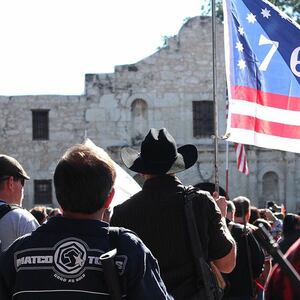If you were to ask an Apple Mac Pro (made in Austin, a city named for the founder of Texas independence) to pick the hottest hot button issue in Texas history, the answer would be the 1836 siege and Battle of the Alamo, the creation myth of Texas. Mess with the Alamo, and you’re messing with Texas.
Jason Stanford, writer and political consultant, Chris Tomlinson, veteran journalist and Texas historian, and Bryan Burrough, author of Public Enemies and Barbarians at the Gate, three very different writers, have collaborated to produce a book that has outraged a significant number of Texans, including Lt. Gov. Dan Patrick, who canceled a virtual forum on the book in June, calling it “A fact-free rewriting of Tx history…”
Patrick got the second part right: Forget the Alamo is a rewrite of Texas history, one that has been a long time a’comin’. But fact-free it isn’t, and it’s the facts that have a great many older white Texans riled:
ADVERTISEMENT
—The Daughters of the Republic of Texas, the self-appointed guardians of the Alamo legend, are torched: By the 1960s they “had evolved into a kind of paramilitary Junior League… the Daughters were the humorless school marms of the Alamo.”
—Alamo buffs, such as British rock star Phil Collins, who have polluted the historical waters with questionable “artifacts,” are put to the sword. Collins’ illustrated book, The Alamo and Beyond: A Collector’s Journey, is “a source of ridicule and horror in the Alamo-collecting and archaeological world.”
—Mythmongers like Fox & Friends’ Brian Kilmeade, who in his 2019 best-selling book Sam Houston and the Alamo Avengers referred to slaves as servants, are sent to the firing squad.
Simply, “Much of what you think you know about the Alamo is wrong.” Let’s spend no more time getting to this: The primary cause of the Texas Revolution wasn’t General Santa Anna’s tyranny and the suppression of the rights of the Anglo colonists. Stephen Austin, “the father of Texas,” thought Santa Anna a friend to the American immigrants; as late as 1835 the general was giving them just about everything they asked for. “Contrary to myth, Santa Anna was not some bloody tyrant, nor even a dictator; that would come later.” At this point, just before the Texas Revolution began in October 1835, “He was an astute politician who needed the support of Congress, the Church, the military, and the people, and thus remained keenly alert to ripples in the Mexican political pond.”
The biggest ripple was slavery. The Mexicans had to settle Texas and couldn’t defend settlers from depredations by the terrifying and aggressive Comanches, so Americans—armed Americans—were enticed there by land grants. The problem was that “the only reason Americans would come to Texas was to farm cotton, and they would not do that without slaves. They really didn’t know any other way.”
The Mexican government couldn’t begin to control immigration across its wide and distant border with its powerful neighbor, the United States—a wall certainly would have come in handy—and by 1825 one of four people living in Austin’s Anglo colony was a slave. Most Texians, settlers who immigrated from the U.S., were contemptuous of Mexican authority and continued to live as if they were still governed by American law. To add more fuel to the growing fire, Santa Anna, who had become the most powerful man in Mexico, “correctly suspected President Andrew Jackson had designs on Texas …” and the Mexican government had to be careful not to provoke the U.S.
The anxieties of slave-owning Texians finally erupted into insurrection. The Anglos enjoyed an early success in October 1835, when they routed the Mexican garrison in San Antonio and seized the old mission-fort, the Alamo, with its 21 cannon. But the victory blinded the Texians to an important fact: they had no army. After all, “Most Texians and Tejanos [Mexican citizens who had migrated to Texas] had farms and businesses to run… Most hadn’t asked for this fight anyway.”
Luckily, a swarm of militias—such as the Huntsville Rovers from Alabama, the Natchez Mustangs from St. Louis, and the New Orleans Greys—flocked to the Texian cause. Luckily, too, the Texians found a charismatic leader in Sam Houston, former governor of Tennessee and veteran of the 1812 War, where he served under Jackson. Once Houston assumed command of Texas’s rag tag forces, events moved rapidly. Santa Anna, who considered himself as the “Napoleon of the West,” assembled a mixed force of professionals and untrained peasants. They lurched slowly north, reaching the outskirts of San Antonio near the end of February 1836. The response of the roughly two hundred Texians under the command of the fabled adventurer Jim Bowie and William Travis, an Alabamian gone to Texas for a new life, was to dig in and hunker down behind the Alamo’s unfinished walls.
Why they didn’t choose to retreat north to join Houston isn’t known. Houston thought the quarter-mile-long compound indefensible, at least by a garrison that could have been no more than 250 men. Travis and Bowie, though, “for whatever reason—honor, duty, ego, overconfidence, or strategy—were determined to defend the Alamo, no matter what. It was, in every respect, a questionable decision.”
On March 6, after 12 days of siege, Santa Anna assembled his troops in the cold and dark and, around 4 or 5 a.m., ordered an assault. After perhaps 90 minutes of bloody hand-to-hand fighting with bayonets and Bowie knives, all the defenders, including at least nine Tejanos, were dead. (Santa Anna had made a show of allowing a handful of women to be escorted out before the assault began.)
“Travis,” say the authors, “and the letters he would write from the old Spanish mission have been held up for nearly two hundred years as heartbreaking evidence of his selfless bravery …”
“But it’s equally true that none of this needed to happen. None of the Alamo’s defenders needed to die—and they only did so because Travis and Bowie ignored every warning of Santa Anna’s approach and inexplicably remained in San Antonio to defend an indefensible outpost.”
Why haven’t we forgotten the Alamo? Mostly for two reasons. The first is that one of the two most famous Americans alive in 1836 (Andrew Jackson the other) died there. David Crockett was a frontiersman, former congressman, and cracker barrel humorist—think of a cross between Bear Grylls and Andy Griffith—who went west to restore his fortunes, arriving in San Antonio just days before the Mexican army. Even the Mexicans knew who he was; in the account of a Mexican officer named Jose Enrique de la Pena he is referred to as “the naturalist David Crockett.” In time, thanks to Walt Disney, Fess Parker, and John Wayne, Crockett’s story consumed those of Bowie, Travis, and the others.
The second reason is Houston’s flare for propaganda. Within 48 hours he was sending out letters likening the disaster at the Alamo to Thermopylae, where 300 Spartans died holding a pass against the Persian Army in 480 B.C. Desperately trying to forge a mob of farmers and woodsmen into an army, Houston turned the crushing defeat into a popular and potent weapon.
Six weeks after the fall of the Alamo, Houston’s army surprised Santa Anna at San Jacinto, captured him, and forced a treaty which gave Texas its freedom. Houston fired up his men before the battle, shouting “Trust in God and fear not. And remember the Alamo!”
Still, for decades the Alamo was mostly forgotten. In 1886 there was no official commemoration of the fiftieth anniversary. The battle was absent from some historical narratives on Texas history or reduced to little more than a side story. The Alamo itself was so neglected that over a few decades only the chapel and the adjacent long barrack where much of the fighting took place were standing. (In Lonesome Dove, Tommy Lee Jones’ Woodrow Call and Robert Duvall’s Gus McCrae—both former Texas Rangers—ride into San Antonio and pass the sad wreck of the chapel without a nod of recognition.)
Near the end of the century, though, the Alamo was revived to become “the great creation myth of Texas, a heroic narrative written and shaped by men—and a few women—who instilled in it the value of their times. Their efforts would prove remarkably enduring. For 150 years, the world pretty much agreed on what the Alamo symbolized.”
The story of the Tejanos such as Juan Sequin, who defied Santa Anna and fought and died at the Alamo, was erased, and the issue of slavery was traded for the more attractive causa belli: the myth of suppression of the rights of Texians.
The 20th century accounts established “the foundation of what we call the Heroic Anglo Narrative of Texas history. They portrayed Anglo Texans as God’s righteous democratic warriors… two-legged arguments for American expansion and manifest destiny.” That spirit lives on in the Texas State Board of Education, which has declared “schoolchildren must be taught a ‘heroic’ version of Alamo history… ‘Alamo heroism’ thus remains the law of the land.”
That law is being rewritten as a generation of new historians have begun taking the field back from popularizers and propagandists. The result is a culture war which could dictate how future generations of Texans—and by extension, Americans and many around the world—perceive the history of Texas.
“Stop political correctness in our schools,” Gov. Greg Abbott tweeted in 2018. “Of course, Texas schoolchildren should be taught that Alamo defenders were ‘heroic’!”
On Aug. 17, ground was broken in San Antonio for the new Exhibition Hall, a key part of the $450 million “Reimagining the Alamo” project, after a protracted dispute between Lt. Gov. Patrick and Texas Land Commissioner George P. Bush (son of Jeb Bush and Senate candidate not endorsed by Donald Trump). The local Caller-Times noted, “When the ‘Reimagining the Alamo’ project first began to take shape about six years ago, Patrick denounced some of its proposed features as a cave-in to 21st century political correctness. Bush, whose mother was born in Mexico, suggested that critics of the project who objected to the attention paid to both Mexican soldiers and Tejano defenders under the ‘reimagine’ plan were ‘racist.’” Now it appears the two have come to an agreement as to what the reimagining will say about the Alamo. So we’ll have to wait for the new official version of the story.
“History doesn’t really change,” the authors tell us, “but the way we view it does.” Forget the Alamo isn’t revisionist history as its critics are claiming. As historian Jeff Long puts it, “To me, the earlier tales about the Alamo were the revisionism. What came later was the history, in a weird inversion.”
Said another way, when the fact became legend, the legend was printed. Now, the legend is giving away to the facts. When the smoke clears from the wildcat fire this book has caused, we’ll still remember the Alamo but in a much different way.






